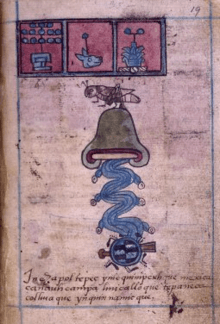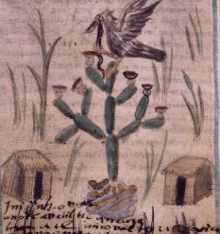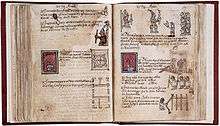Aubin Codex

The Aubin Codex is a textual and pictorial history of the Aztecs from their departure from Aztlán through the Spanish conquest to the early Spanish colonial period from 1519-1521, ending in 1608.[2] Consisting of 81 leaves, the codex is written in alphabetic Nahuatl, the language of the Aztec empire, on European paper.[1]
History
While the Aubin Codex may have been first written in 1576, the date on its frontispiece, various Nahuatl-speaking authors worked on it at least until 1608, the last recorded date in the manuscript. Its 17th-century history is unknown. By the mid-18th century, it was in the hands of Lorenzo Boturini-Benaducci.[3] The codex was named after J.M.A Aubin, who owned it in the mid-1800s. He published a lithographic reproduction in 1893.[4] The last person to own the original was Jules Desportes. It now resides in the British Museum.[5]
Contents
The Aubin Codex is actually two manuscripts, bound together as one. The first is an annals account of the Mexica of Tenochtitlan, beginning with their migration out of Aztlan in the year 1 Flint, correlated to 1168 in the manuscript. [1] It includes the foundation of Tenochtitlan, and the cataclysmic events of the conquest-era, including the smallpox epidemic after the arrival of the conquistadors,[5] and the massacre at the temple in Tenochtitlan in 1520.[6] James Lockhart has published an English translation of the Codex Aubin's Nahuatl account of the conquest of Mexico.[7] According to Lockhart, internal evidence suggests that the main author was a man from the Mexico-Tenochtitlan sector of San Juan Moyotlan, who drew on existing material, including oral sources, for his account of the earlier era, and then began an eyewitness account of the events of the late sixteenth century.[8] Unlike the account of the conquest of Mexico in the Florentine Codex, which is primarily from the Tlatelocan viewpoint and denigrates the Mexica of Tenochtitlan, Codex Aubin offers the Mexica perspective and makes no reference to events in Tlatelolco.[9]
Style
The Codex Aubin is written in mixed pictographic-alphabetic format, and a number of painters and writers worked on it.[10]:210 The first part of the Codex Aubin, consisting of the Mexica migration history from Aztlan to Tenochtitlan, is written in clustered annals structure.[10]:85 Years, represented by hieroglyphs in square cartouches, are grouped in rows or columns, these year blocks allowing more space for a longer alphabetic text. The years are written from left to right and top to bottom.[10]:209The next part of the codex, covering the period after the foundation of Tenochtitlan, is written in a more conventional annals structure, with a vertical block of five years on each page, and a record of corresponding events, rendered with images and alphabetic text. From 1553 to 1591 (fol. 48v-67v), each page is devoted to the events of a single year. The last part of the codex was originally an entirely separate manuscript, and lists the native rulers of Tenochtitlan from its founding until 1608. [11]

Today
As of 2015, Fordham University has been hosting a project to translate the codex into English and further decipher its images and pictographs.[11] Also called "Manuscrito de 1576" (“The Manuscript of 1576”), this codex is held by the British Museum in London.[1] A copy of the original is held at the Princeton University library in the Robert Garrett Collection.[12]
References
- 1 2 3 4 5 6 "Image gallery: Codex Aubin / Códice Aubin 1576 / Códice de 1576 / Historia de la nación mexicana / Histoire mexicaine". British Museum. Retrieved 2018-02-01.
- ↑ Gibson, Charles. "Prose sources in the Native Historical Tradition", article 27B. "A Census of Middle American Prose Manuscripts in the Native Historical Tradition". Guide to Ethnohistorical Sources Part 4; Handbook of Middle American Indians. University of Texas Press 1975, census #1014, pp.327-28
- ↑ Glass, John B. “The Boturini Collection.” In Handbook of Middle American Indians, edited by Howard F. Cline, 15:473–86. Guide to Ethnohistorical Sources 4. Austin, Texas: University of Texas Press, 1975.
- ↑ Aubin, José Mario Alejo. Histoire de la nation mexicaine depuis le départ d’Aztlan jusqu’a l’arrivée des conquérants espagnols (et au delà 1607): Ms. figuratif accompagné de texte en langue nahuatl ou mexicaine suivi d’une trad. en français par J.M.A. Aubin ; Reprod. du codex de 1576. Documents pour servir à l’histoire du Mexique. Paris: Leroux, 1893.
- 1 2 "Nahuatl Spoken Here - Marriott Library - The University of Utah". www.lib.utah.edu. Retrieved 2018-02-02.
- ↑ "Conquest · Codex Aubin · Codex Aubin". codexaubin.ace.fordham.edu. Retrieved 2018-02-02.
- ↑ James Lockhart, We People Here: Nahuatl Accounts of the Conquest of Mexico, translated and edited. University of California Press, 1991, pp.274-279; commentary p. 314
- ↑ James Lockhart, We People Here: Nahuatl Accounts of the Conquest of Mexico, translated and edited. University of California Press, 1991, p. 43
- ↑ James Lockhart, We People Here: Nahuatl Accounts of the Conquest of Mexico, translated and edited. University of California Press, 1991, p. 43
- 1 2 3 Boone, Elizabeth Hill (2000). Stories in Red and Black" Pictorial Histories of the Aztecs and Mixtecs. University of Texas Press. ISBN 978-0-292-71989-7.
- 1 2 "About · Codex Aubin". codexaubin.ace.fordham.edu. Retrieved 2018-02-01.
- ↑ "Princeton University Digital Library -- Item Overview". pudl.princeton.edu. Retrieved 2018-02-02.
External links
- British Museum.org: Aubin Codex — catalogue record, Reference number AN237162001. Includes full-color digitized copy.
- Codex Aubin, MSS 279 Series 9 at L. Tom Perry Special Collections, Brigham Young University.
